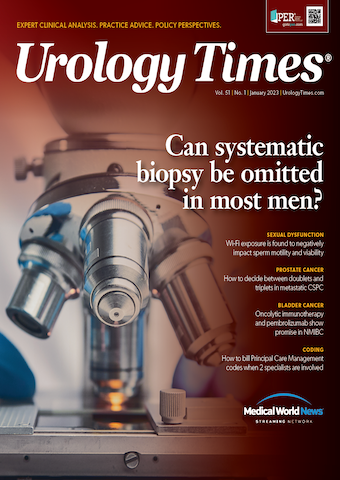Publication
Article
Urology Times Journal
FDA updates label for mitomycin gel in UTUC
Author(s):
The FDA has updated the label for mitomycin-containing reverse thermal gel (Jelmyto) in low-grade upper-tract urothelial cancer (LG-UTUC) by extending the in-use period for pyelocalyceal solution admixture from 8 hours to 96 hours (4 days) following reconstitution of the product, according to UroGen, the developer of the treatment.1
“This extension expands access to Jelmyto and gives our customers greater flexibility in choosing when to mix and schedule instillations. It also prepares us for managing future growth based on increased patient volume.” Jeff Bova, chief commercial officer, UroGen, stated in a press release.
“This label change for Jelmyto gives physicians and patients the option to treat in the morning, whereas, in most cases, the afternoon was the only option before the change,” Rian Dickstein, MD, chairman of Urology, University of Maryland Baltimore Washington Medical Center, added in the press release. “Previously, centers with mixing partners had to have Jelmyto mixed and sent by courier in the morning, now this extension provides added convenience of opening up additional scheduling options, which is very important as it enables us to more efficiently manage patient care.”
The FDA approved mitomycin gel for LG-UTUC in April 2020, based on findings from thephase 3 OLYMPUS trial (NCT02793128).2 Long-term data from OLYMPUS presented at the 2021 AUA Annual Meeting showed that mitomycin gelinduced a durable recurrence-free survival benefit in patients with LG-UTUC.3
As of March 4, 2021, the median duration of response (DOR) achieved with mitomycin gel induction therapy was 28.1 months (95% CI, 14.6-37.1) in 15 evaluable patients. Eighty percent of patients (n = 12) experienced a durable response, defined as having no evidence of recurrence or not having to undergo radical nephroureterectomy.
Twenty percent of patients (n = 3) did not experience a durable response because of disease recurrence (13%; n = 2). One patient needed to undergo radical nephroureterectomy (7%); however, notably, this was performed because of ureteral stricture rather than disease recurrence.
Patients who experienced recurrence underwent endoscopic ablation. None of the patients with disease recurrence progressed to high-grade disease. At the time of the last follow-up, the disease-specific survival rate was 100%.
The open-label, single-arm, phase 3 OLYMPUS trial enrolled a total of 71 patients with LG-UTUC who had never undergone treatment or who had recurrent low-grade, noninvasive disease with at least 1 measurable papillary tumor.
Study participants received mitomycin gel once a week for the duration of 6 weeks followed by a 4- to 6-week grace period. In this period, patients were assessed for the primary efficacy end point of CR rate at their primary disease evaluation (PDE) visit. If patients experienced a CR to treatment, they went on to receive the gel monthly for up to 11 additional months.
Patients were determined to have a complete response (CR) if ureteroscopy and cytology were entirely normal. If there were any abnormalities, patients underwent a biopsy by which this was determined to be either recurrence or a CR.
A key secondary end point of the trial was durable response at the 12-month follow-up visit, and other end points included durability of response with mitomycin gel at 3, 6, and 9 months following the PDE visit. As part of the long-term follow-up, investigators examined duration of response, disease recurrence, disease progression, and death.
The primary analysis of the trial was done on the intention-to-treat (ITT) population, which comprised patients who were given 1 or more instillation of the gel. Secondary analyses were conducted in patients who achieved a CR at the time of their PDE visit, and long-term follow-up analyses looked at those who had a CR at 12 months following their PDE visit.
Of the 71 patients enrolled to the study (ITT population), 10 discontinued mitomycin gel (9 because of adverse effects [AEs] and 1 because of withdrawn consent), and 19 did not achieve a CR by their PDE visit. A total of 42 patients in the ITT population experienced a CR to treatment at the time of their PDE visit, which translated to a CR rate of 59.2% (95% CI, 46.8%-70.7%). Of these patients, 1 withdrew consent, 10 discontinued treatment, and 8 experienced disease recurrence.
Twenty-three patients maintained their CR at 12 months, translating to a CR rate of 56.1% (95% CI, 39.7%-71.5%). Five of these patients were at sites where follow-up protocol was not yet initiated, 2 did not have data available, and 1 was lost to follow-up. The data presented at the 2021 AUA Annual Meeting were for the remaining 15 evaluable patients.
References
1. FDA Authorizes an Extension of the In-Use Period for UroGen Pharma’s JELMYTO® Admixture to 96 Hours Following Reconstitution. Published online September 29, 2022. Accessed September 29, 2022. https://bwnews.pr/3UOGbfL
2. FDA approves first therapy for treatment of low-grade upper tract urothelial cancer. News release. FDA. April 15, 2020. Accessed September 13, 2021. https://bit.ly/3liG6jn.
3. Kleinman N, Pierorazio P, Raman JD, et al. Long-term recurrence-free survival following UGN-101 treatment for low-grade upper tract urothelial carcinoma. Presented at: 2021 American Urological Association Annual Meeting; September 10-13, 2021; virtual. Abstract LBA02-10





























